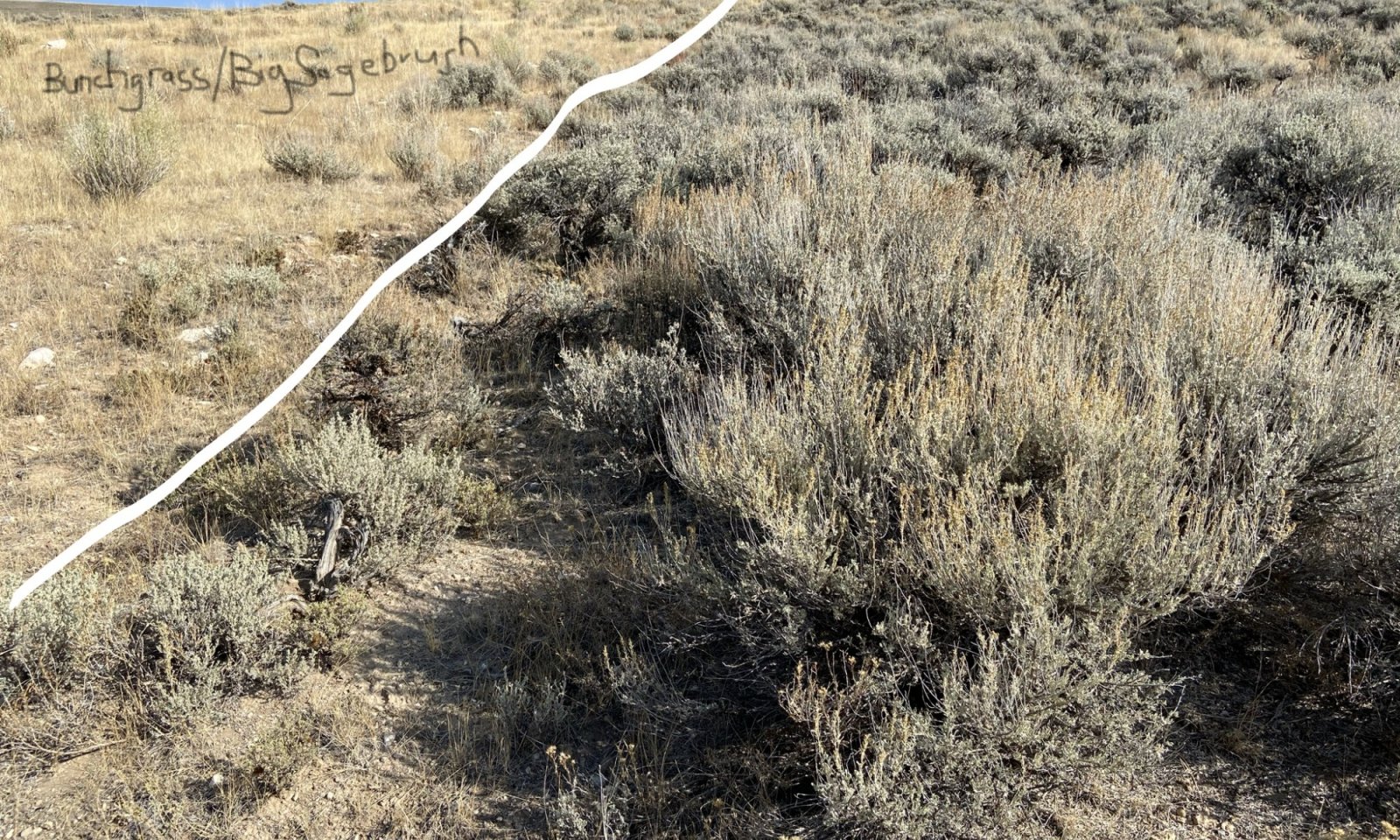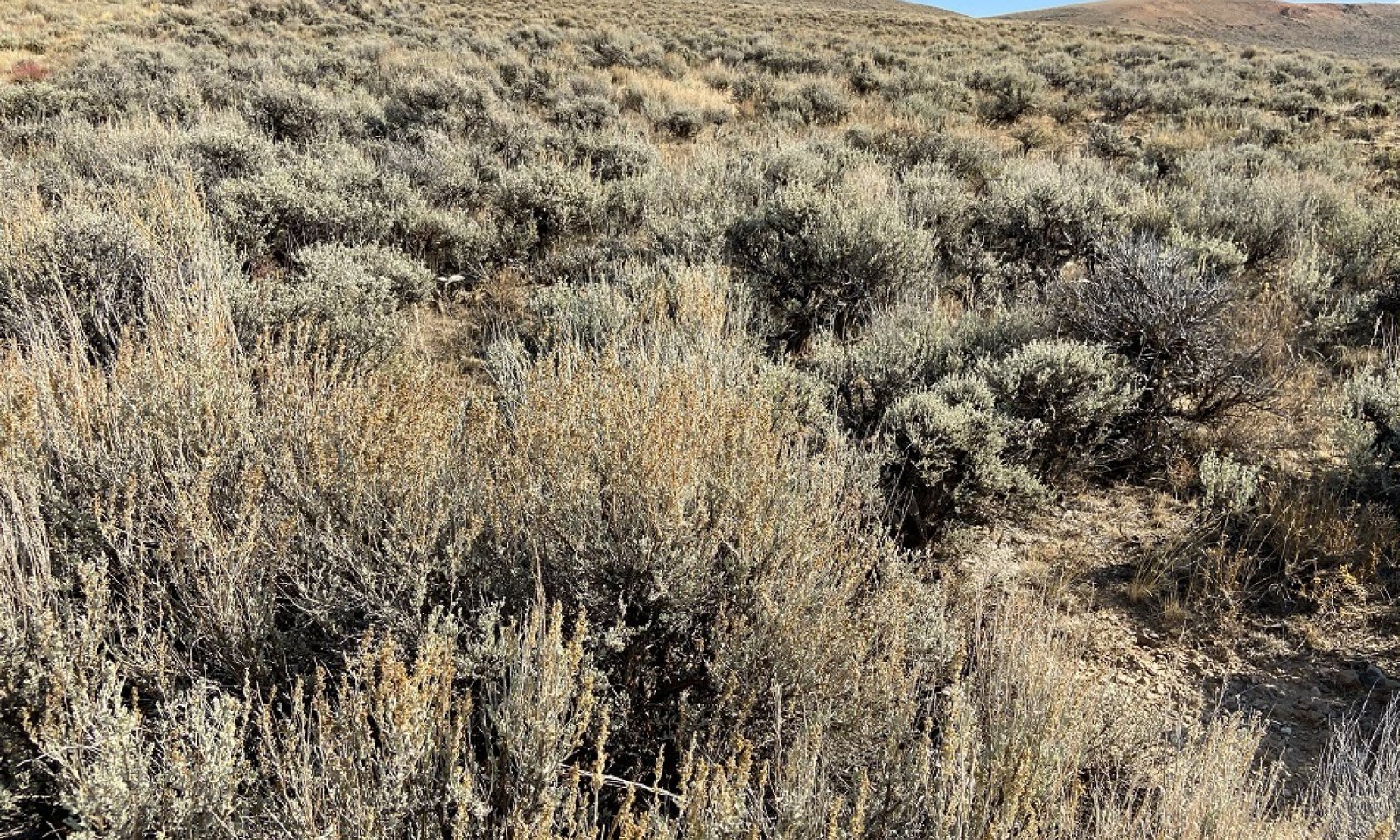
Shallow Loamy Bear River Valley 10-14" P.Z.
Scenario model
Current ecosystem state
Select a state
Management practices/drivers
Select a transition or restoration pathway
-
Transition T1A
Herbivory (continuous or season-long, low to moderate stocking)
More details -
Transition T1B
Soil disturbance (e.g. hoof action, rodents, water erosion) and/or high intensity fire or chemical/mechanical treatment
More details -
Transition T2A
Soil disturbance (e.g. hoof action, rodents, water erosion) and/or catastrophic wildfire or chemical/mechanical treatment
More details -
Transition T2B
Extreme herbivory (continuous, high intensity)
More details -
Transition T3A
Extreme disturbance (e.g. catastrophic fire, drought, soil removal)
More details -
No transition or restoration pathway between the selected states has been described
Target ecosystem state
Select a state
Description
The Reference State consists of two plant communities: the Big Sagebrush/Bunchgrass Plant Community and the Bunchgrass/Big Sagebrush Plant Community. Each plant community differs in percent composition and foliar cover of bunchgrasses and Wyoming big sagebrush (Artemisia tridentata ssp. wyomingensis) as the dominant shrub. Forbs are a minor component.
Two important processes occur in the Reference State and result in plant community changes: 1) sagebrush-killing disturbances such as herbivory, drought, prolonged soil saturation, and to a lesser extent fire; and 2) time without those disturbances, generally referred to as "natural succession."
Characteristics and indicators
The shift between plant community phases is dependent upon sagebrush-killing disturbances, and without them sagebrush will increase even with proper grazing management. Improper grazing management may accelerate the rate of increase for the shrub component.
Management actions or treatments are not prescribed or used to mimic the natural disturbance regime due to fragile nature of the soils and lower productivity potential on this site. Prescribed fire is not used due to land use and ownership patterns and lack of fine fuels (Clause and Randall, 2014).
Resilience management
This site has moderate resilience due to its xeric soil moisture regime and frigid temperature regime (Chambers et.al. 2014). Precipitation is typically adequate and more effective with cooler temperatures, but timing of precipitation lowers resilience. Moisture is often not present when needed to support recovery efforts. The site can usually recovery after disturbance but is susceptible to delays in recovery during extreme climatic events such as drought.
The site has moderately low resistance to invasion by annual grasses because of climate suitability. Winter precipitation patterns favor annual invasion while cooler temperatures provide some resistance. The site is susceptible to invasion during hotter climatic periods.
Submodel
Description
The Grazing Resistant State has seen a shift in under-story functional/structural group dominance. Due to herbivory pressure, there is a shift from mid-stature cool-season bunchgrasses to short-stature cool-season bunchgrasses such as Sandberg bluegrass and rhizomatous wheatgrasses like thickspike wheatgrass and western wheatgrass. Mat-forming forbs such as pussytoes (Antennaria spp.), Hood's phlox (Phlox hoodii), and buckwheat (Eriogonum spp.) increase and can become dominant.
Characteristics and indicators
There are fewer mid-stature bunchgrasses and they are typically found under the shrub canopy where they are protected from herbivory. The shrub canopy inter-spaces are occupied by grazing tolerant grasses as well as patches of bare ground that are sometimes connected. Canopy gaps and bare ground increase, while herbaceous foliar cover decreases. Drier site conditions result in lower productivity and less herbaceous production potential. Decreased infiltration is caused by increased bare ground patch size and lack of litter that acts as mulch in retaining soil moisture and retarding runoff.
In many cases, the transition to the Grazing Resistant State may have occurred many decades ago during an era of higher stocking rates and continuous grazing during the growing season. However, continual grazing during the critical growth period (roughly May through June) at proper stocking rates will facilitate the transition to this state and maintain it as a stable state.
Resilience management
Site resilience is lower than the Reference State. Site hydrology has been modified due to moisture being utilized by shallower rooting species. Therefore, the site is drier earlier in the season and unable to recover as quickly after a disturbance. This state is more drought-prone, and therefore more vulnerable to invasion by annual invasive species. However, existing sagebrush canopy and remnant perennial vegetation provide some amount of resiliency. Rhizomatous grasses form mats that provide soil protection by protecting the soil from raindrop impact, decreasing the risk of soil erosion. However, overall soil stability is lower than the reference state, primarily due to a reduction in soil organic matter due to a reduction in litter.
Site resistance to invasion by annual grasses is lower due to niches in the under-story for establishment as well as site water availability during the time suited for winter annuals such as cheatgrass (Bromus tectorum). Episodic and limited moisture is more suited to annual life forms.
Submodel
Description
The Disturbed State is a result of soil-disturbing activities outside of the normal disturbance regime expected for this site. Examples are high intensity hoof action, anthropogenic activity, rodent activity, or frequent prolonged soil saturation, which includes occasional irrigation. It may also occur after brush management preceded or followed by improper grazing techniques that include high-intensity grazing use without appropriate recovery periods.
Brush management treatment methods are typically chemical (including 2,4-D or tebuthiron) due to soil limitations to mechanical treatment. Herbivory (including browse and/or insects) can contribute to disturbances affecting this state. High intensity fire could be a factor in maintaining this plant community by stimulating sprouting shrubs (rabbitbrush) and killing sagebrush.
Characteristics and indicators
There is a shift toward sprouting shrub dominance or co-dominance with big sagebrush depending on how long it has been since the disturbance(s). Both green and rubber rabbitbrush may be present. Along with a shift in shrub species, the herbaceous under-story also shifts toward more disturbance tolerant species such as rhizomatous wheatgrasses. Annual weeds such as bur buttercup, flixweed, and lambsquarter, and invasive annual grasses such as cheatgrass are are often present in small amounts (less than 5 percent composition by dry weight).
Resilience management
Site resilience is lower than the Reference State or Grazing Resistant State, but higher than the Invaded State. Site hydrology has been modified due to moisture being utilized by shallower rooting species. Therefore, the site is drier earlier in the season and unable to recover as quickly after a disturbance. However, existing sagebrush canopy and remnant perennial vegetation provide some amount of resiliency. Site resistance to invasion by annual grasses is lower due to niches in the under-story for establishment as well as site water availability during the time suited for winter annuals such as cheatgrass (Bromus tectorum). Episodic and limited moisture is more suited to annual life forms during drought.
Submodel
Description
The Invaded State has seen a shift in dominance toward annual invasive grasses. It often occurs after a disturbance that occurs in conjunction with drought conditions.
Characteristics and indicators
In this state, sagebrush canopy varies, but the under-story is dominated by annual invasive and weedy species. There will be indicators of reduced soil and site stability as well as reduced hydrologic function, mainly water flow patterns and pedestals, but potentially rills and gullies. Soil surface loss and degradation is likely. Biotic integrity is affected by functional/structural groups not expected for the site, invasive plants, and the loss of perennial species and functional/structural groups.
The site is more prone to drought with large fluctuations in annual production in response to weather events. The site is less diverse with lower quality habitat for wildlife and pollinators, and the risk of wildfire is increased from fine fuel production.
Resilience management
Site resilience is lower than all other states because the site hydrology has been modified resulting in greater runoff during spring melt and rainfall events. Therefore, the site is drier and unable to recover as quickly after a disturbance. Site resistance to invasion by annual grasses is lost due to niches in the under-story for establishment as well as site water availability during the time suited for winter annuals such as cheatgrass (Bromus tectorum). Episodic and limited moisture is more suited to annual life forms.
Submodel
Mechanism
Herbivory pressure in excess of normal Reference State conditions. A typical scenario is continuous spring or season-long grazing with low stocking intensity.
Constraints to recovery
Recovery is inhibited by continued herbivory pressure, reduced seedbank, and drought conditions. Annual grasses are likely in small amounts.
Context dependence
Drought and annual invasion are most likely variables to prevent restoration.
Mechanism
Soil-disturbance outside of the normal disturbance regime expected for this site. Examples include high intensity fire, high intensity hoof action, anthropogenic activity (e.g. mechanical and/or chemical treatments), rodent activity, or prolonged soil saturation, which includes occasional irrigation.
Constraints to recovery
Recovery is inhibited by consecutive disturbances over a relatively short time period and drought conditions. Annual grasses are likely in small amounts, increasing with each additional disturbance.
Context dependence
Drought and annual invasion are most likely variables to prevent restoration.
Mechanism
Soil-disturbance outside of the normal disturbance regime expected for this site. Examples include catastrophic wildfire, high intensity hoof action, anthropogenic activity (e.g. mechanical and/or chemical treatments), rodent activity, or prolonged soil saturation, which includes occasional irrigation.
Constraints to recovery
Recovery is inhibited by consecutive disturbances over a relatively short time period and drought conditions. Annual grasses are likely in small amounts, increasing with each additional disturbance.
Context dependence
Drought and annual invasion are most likely variables to prevent restoration.
Mechanism
Extreme herbivory resulting in removal of perennial herbaceous vegetation followed by annual invasion, typically associated with post-drought conditions. It is common for this to occur without a sagebrush killing event, resulting in the shrub/annual plant community.
Constraints to recovery
Recovery is inhibited by fire risk and annual invasion.
Context dependence
Drought and annual invasion are variables that prevent restoration.
Mechanism
Extreme disturbance, including catastrophic wildfire, drought, or other soil removal disturbance, resulting in removal of perennial vegetation followed by annual invasion, typically associated with post-drought conditions.
Constraints to recovery
Recovery is inhibited by fire risk and annual invasion.
Context dependence
Drought and annual invasion are variables that prevent restoration.
Model keys
Briefcase
Add ecological sites and Major Land Resource Areas to your briefcase by clicking on the briefcase (![]() ) icon wherever it occurs. Drag and drop items to reorder. Cookies are used to store briefcase items between browsing sessions. Because of this, the number of items that can be added to your briefcase is limited, and briefcase items added on one device and browser cannot be accessed from another device or browser. Users who do not wish to place cookies on their devices should not use the briefcase tool. Briefcase cookies serve no other purpose than described here and are deleted whenever browsing history is cleared.
) icon wherever it occurs. Drag and drop items to reorder. Cookies are used to store briefcase items between browsing sessions. Because of this, the number of items that can be added to your briefcase is limited, and briefcase items added on one device and browser cannot be accessed from another device or browser. Users who do not wish to place cookies on their devices should not use the briefcase tool. Briefcase cookies serve no other purpose than described here and are deleted whenever browsing history is cleared.
Ecological sites
Major Land Resource Areas
The Ecosystem Dynamics Interpretive Tool is an information system framework developed by the USDA-ARS Jornada Experimental Range, USDA Natural Resources Conservation Service, and New Mexico State University.


